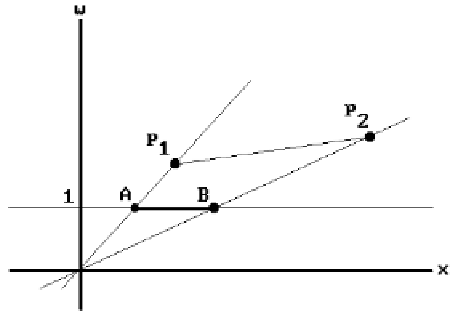Graphics Reference
In-Depth Information
the x, y, or, z axis. For example, the map in Figure 4.19(a) sends the point (x,y,z) to
the point (x,7y,z), which expands everything by a factor of 7 in the y direction.
A lower triangular matrix causes what is called a
shear
. What this means is that
the map corresponds to sliding the world along a line while expanding or contract-
ing in a possibly not constant manner along a family of lines not parallel to the first
line. The same thing holds for upper triangular matrices. For example, consider the
matrix M in Figure 4.19(b). The point (x,y,z) gets sent to (x + 3y,y,z). Points get moved
horizontally. The bigger the y-coordinate is, the more the point is moved. Note that
this map is really an extension of a map of the plane.
Next, consider the map in Figure 4.19(c). This map sends the point (x,y,z) to (x -
1,y + 3,z + 5) and is just a simple translation by the vector (-1,3,5). The map in Figure
4.19(d) sends the homogenous point (x,y,z,1) to (x,7y,z,5), in other words, (x,y,z) is
sent to (x/5,7y/5,z/5), which is just a global scaling. Finally, the map in Figure 4.19(e)
sends (x,y,z) to (x/(2x + 3y + 1), y/(2x + 3y + 1), z/(2x + 3y + 1)). The plane 2x + 3y + 1
= 0 gets sent to infinity. The map is a two-point perspective map with vanishing points
for lines parallel to the x- or y-axes.
We finish this section by describing a way to visualize homogeneous coordinates
and why some caution should be exercised when using them.
The standard embedding of
R
3
in
P
3
maps (x,y,z) to [x,y,z,1]. This means that we
can use the space of 4-tuples, that is,
R
4
, to help us visualize
P
3
. More precisely, since
the lines through the origin correspond in a one-to-one fashion with the points of
P
3
,
we can use the plane w = 1 in
R
4
to represent the
real
points of
P
3
. Furthermore, if
someone talks about a point
p
1
with homogeneous coordinates (x,y,z,w), then we can
pretty much deal with
p
1
as if it actually were that 4-tuple in
R
4
. We need to remem-
ber, however, that if
p
1
lies on a line through the origin and a point
A
on the plane w
= 1, then
p
1
and
A
will represent the same point of
P
3
. See Figure 4.20. Now, once
one decides to use homogeneous coordinates for a graphics problem, although one
usually starts out with a representative like
A
, after one has applied several transfor-
mations (represented by 4 ¥ 4 matrices), one may not assume that the 4-tuple one
ends up with will again lie on the plane w = 1. Although one could continually project
back down to the w = 1 plane, that would be awkward. It is simpler to let our new
The w
=
1 plane in
R
4
.
Figure 4.20.


